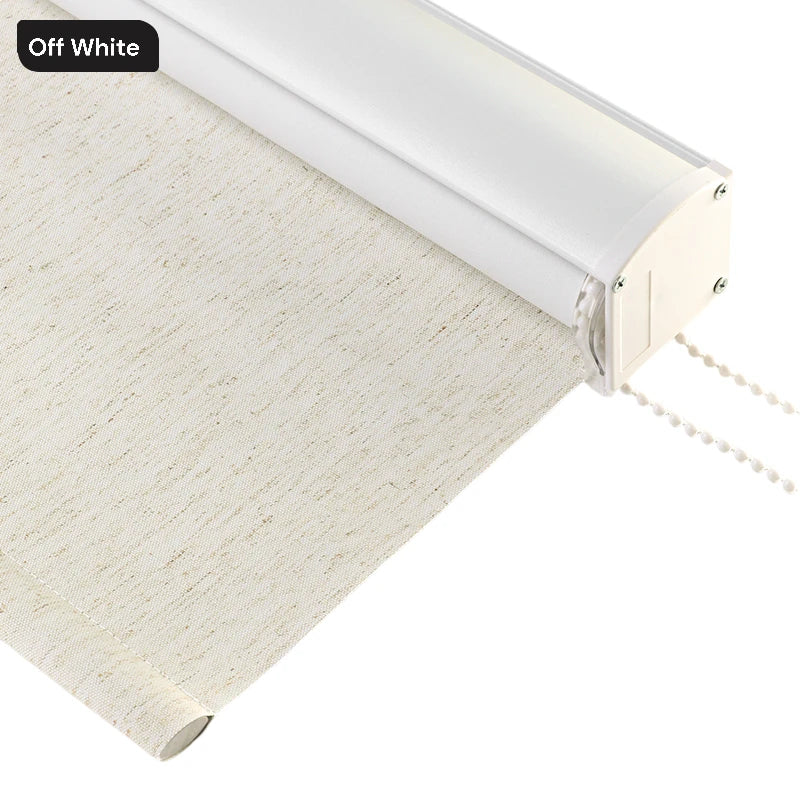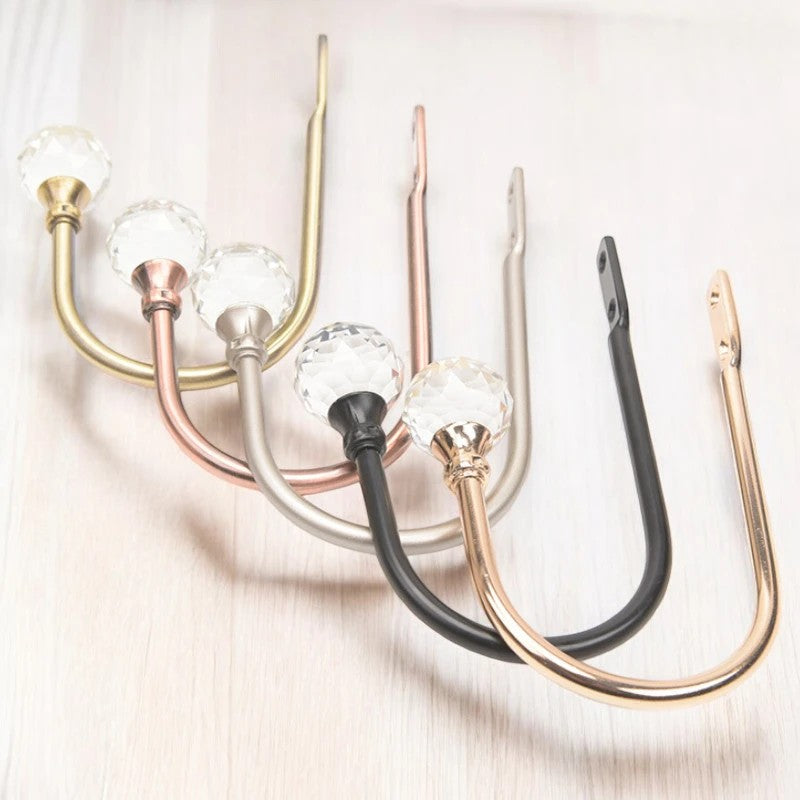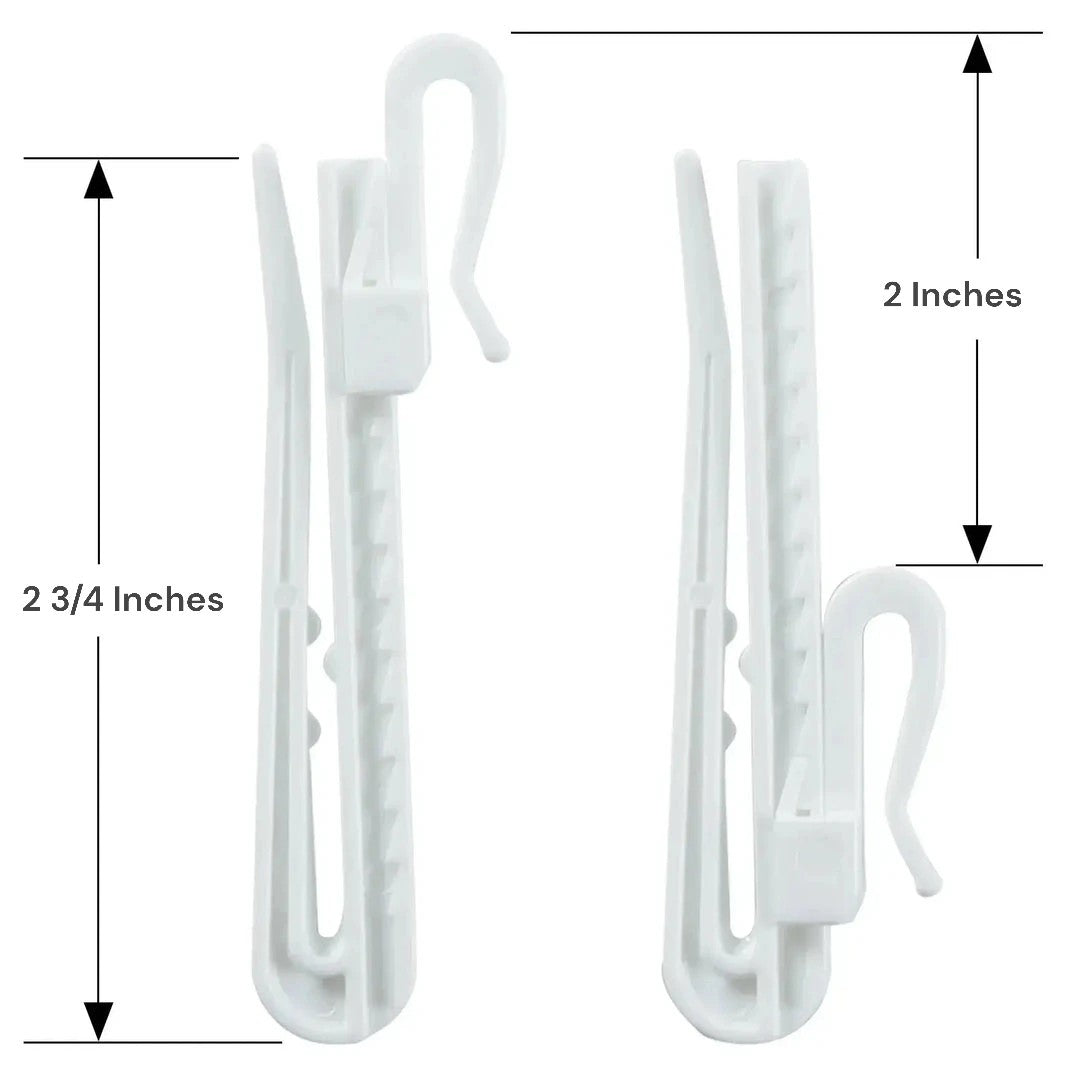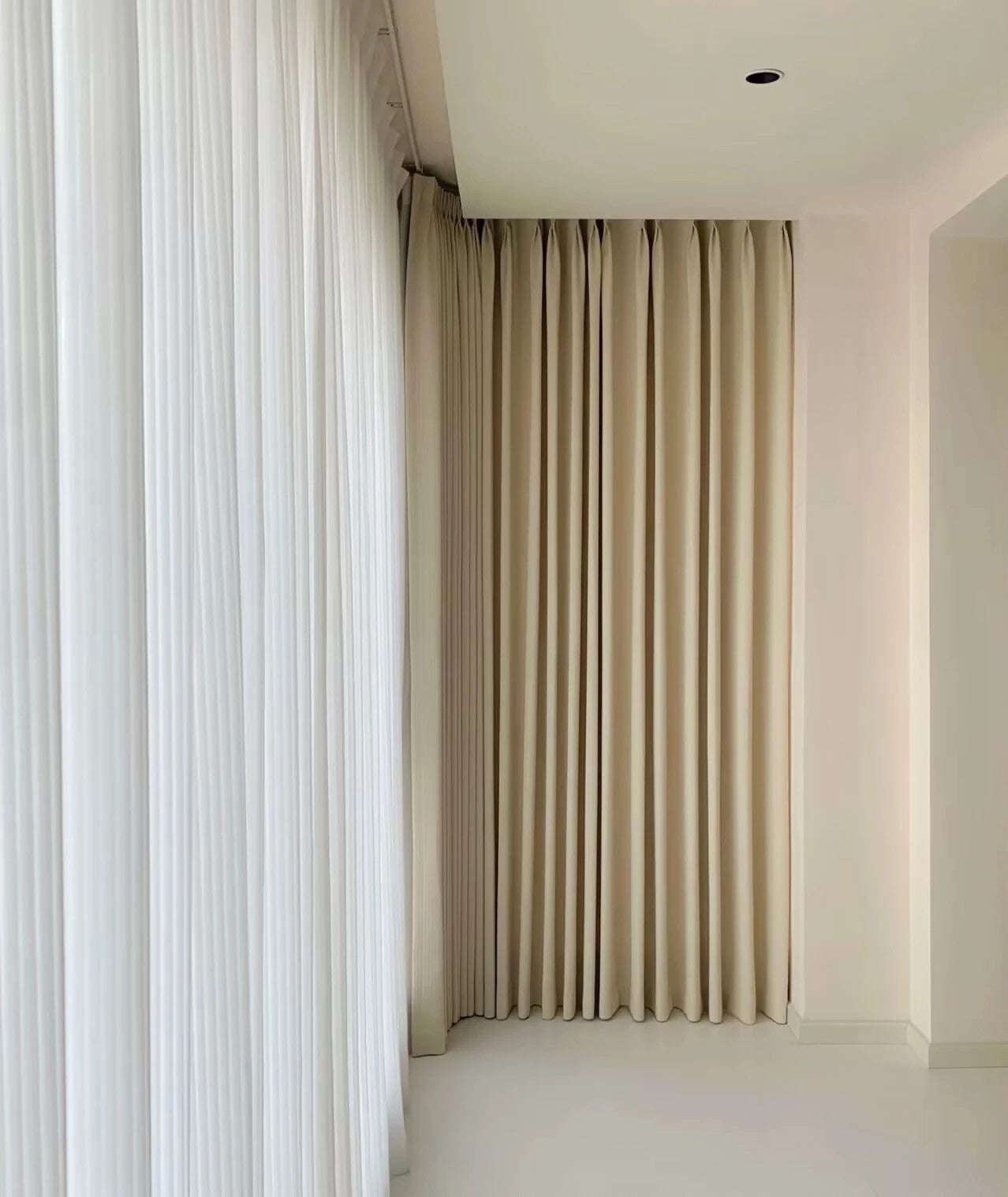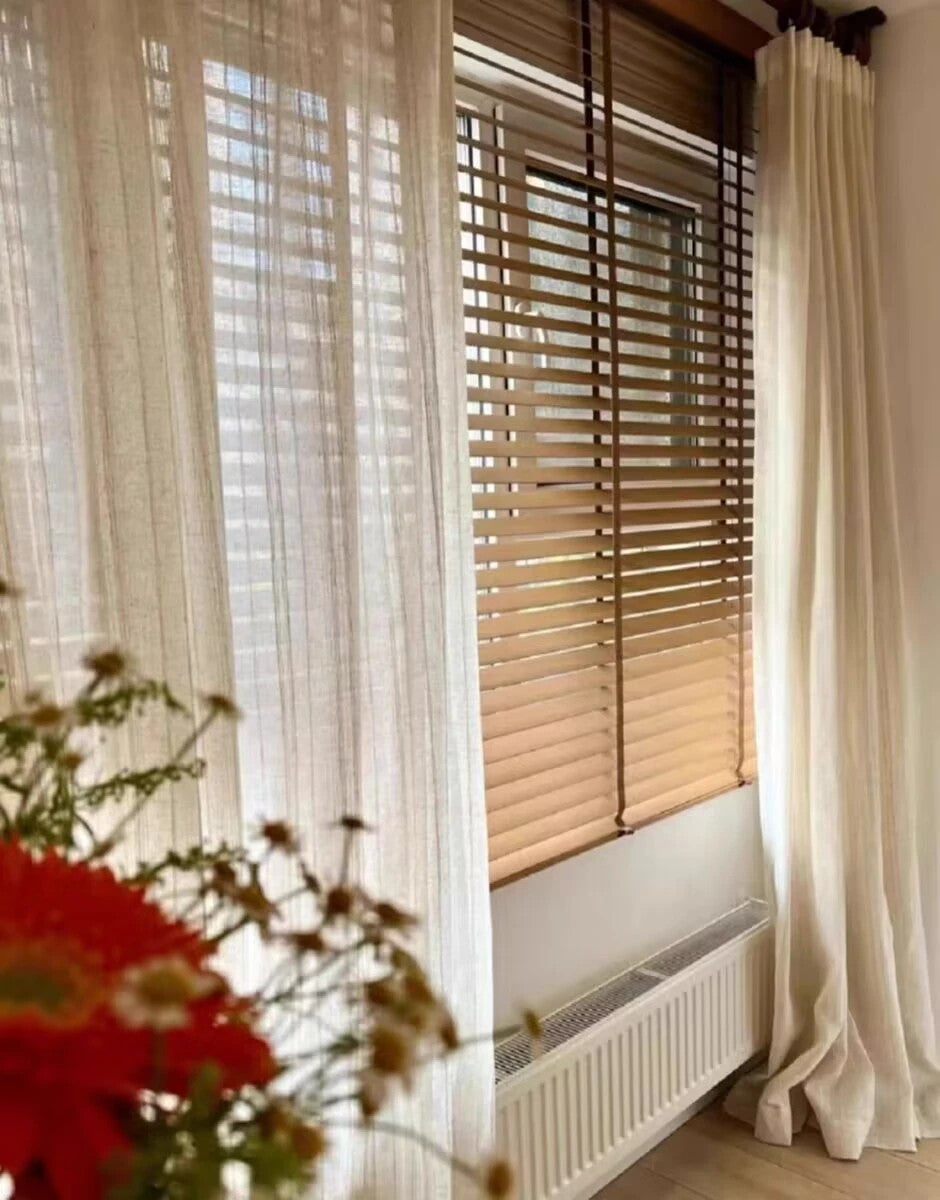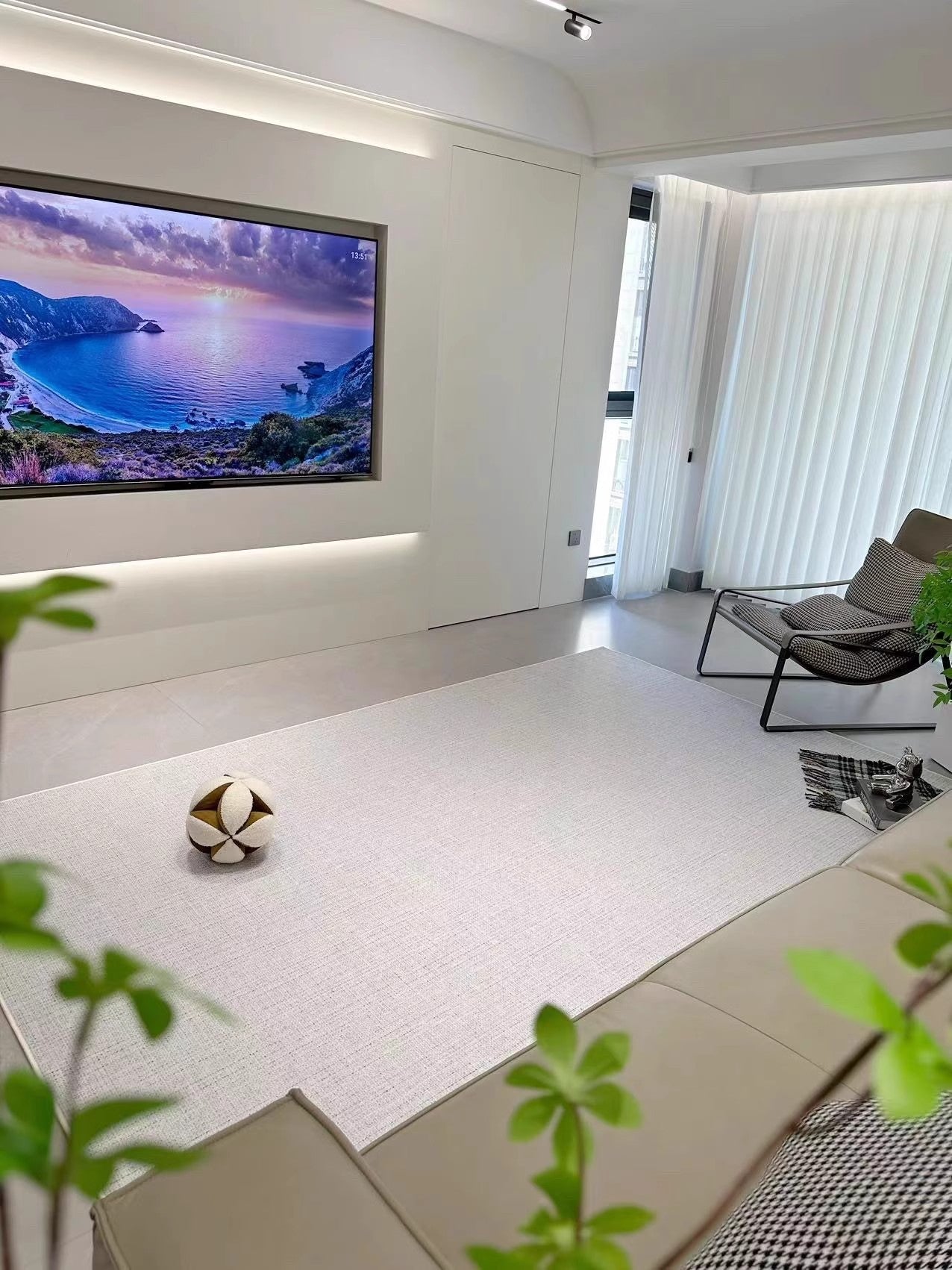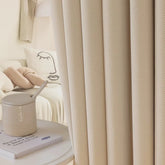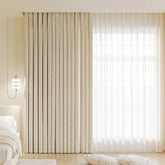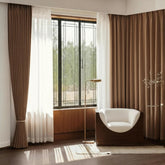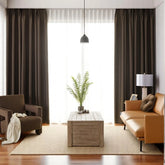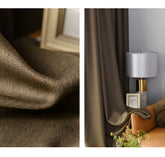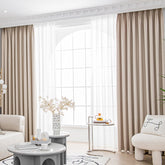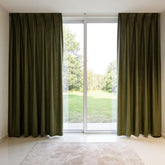¿Qué Tan Alto Deben Colocarse las Cortinas Sobre las Ventanas?: Consejos de Expertos
Cuando se trata de colgar cortinas, es importante considerar la altura a la que deben posicionarse sobre las ventanas. La posición adecuada para colgar cortinas puede hacer una gran diferencia en el aspecto y la sensación general de la habitación. Hemos recopilado algunos consejos de expertos para ayudarle en sus esfuerzos para colgar cortinas.
Puntos clave
- Cuelgue las barras de cortinas entre cuatro y seis pulgadas por encima del marco de la ventana para que la ventana parezca más alta
- Considere variaciones basadas en la altura del techo y el estilo de la ventana
- Elija una barra para cortinas que sea de ocho a 12 pulgadas más ancha que la ventana para que parezca más grande
- Idealmente, la parte inferior de las cortinas debe llegar hasta el suelo
- Elija el hardware adecuado para complementar el estilo de la habitación y asegurar una instalación correcta
Una regla general es colgar la barra de la cortina entre cuatro y seis pulgadas por encima del marco de la ventana. Esto hará que la ventana parezca visualmente más alta. Sin embargo, si tiene techos altos, puede colgar las cortinas a menos de ocho pulgadas desde la parte superior del marco de la ventana. También preste atención al estilo de la ventana. Las ventanas que son arqueadas o tienen formas únicas pueden requerir diferentes alturas de instalación.
Al seleccionar una barra para cortinas, elija una que sea aproximadamente de ocho a 12 pulgadas más ancha que el ancho de la ventana. Esto dará la ilusión de que la ventana es más grande de lo que realmente es. La longitud de las cortinas también es importante: idealmente, la parte inferior de las cortinas debe llegar hasta el suelo para un aspecto elegante y pulido. Sin embargo, si prefiere cortinas que no toquen el suelo, detenerlas aproximadamente una pulgada por encima del suelo también es aceptable.
Finalmente, es importante elegir la herrajería adecuada para las cortinas que complemente el estilo de la habitación y asegure una instalación correcta de los soportes y varillas. Siguiendo estos consejos expertos, puedes colgar tus cortinas de manera que realcen el atractivo estético y la funcionalidad de tu espacio.
Factores a Considerar para la Altura de Colgado de Cortinas
La altura a la que deben colgarse las cortinas depende de varios factores, incluyendo el estilo de la ventana, el tipo de cubierta y la altura del techo. Para lograr la colocación ideal de las cortinas, es importante considerar cuidadosamente estos factores al decidir la altura y el ancho de las cortinas.
| Factor | Consideraciones |
|---|---|
| Aspecto General | Las cortinas deben complementar la estética y el estilo de la habitación. Considera el color y el patrón de la tela y cómo se coordinarán con el resto de la decoración. |
| Ancho y Alto de la Ventana | Toma medidas precisas del ancho y alto de la ventana, incluyendo la distancia entre el marco y el techo. Las cortinas deben ser más anchas y largas que la ventana para crear la ilusión de ventanas más grandes. |
| Altura del Techo | La altura del techo determinará la colocación de la varilla para cortinas. Colgar las cortinas más cerca del techo puede crear la ilusión de mayor altura. |
| Estilo Deseado | Considera el ambiente y estilo general de la habitación. Las cortinas que llegan hasta el suelo pueden crear un aspecto formal y sofisticado, mientras que las cortinas más cortas pueden aportar un ambiente más casual y relajado. |
Para techos estándar, la altura típica para las cortinas es a mitad de camino entre la parte superior del marco de la ventana y el techo. Para techos tipo catedral, las cortinas deben colgarse de 4 a 6 pulgadas por encima del marco para mostrar adecuadamente la altura y grandeza del techo.
El ancho de las cortinas debe ser de 4 a 10 pulgadas más ancho que el marco de la ventana para crear la ilusión de ventanas más anchas. Esto también permite que las cortinas se puedan correr fácilmente al abrir y cerrar las ventanas.
La longitud ideal de las cortinas debe ser lo suficientemente larga para rozar el suelo, con la tela tocando justo o ligeramente por encima del suelo para ventanas activas. Evita cortinas que cuelguen demasiado alto, ya que pueden hacer que los techos parezcan más bajos. Se recomienda que la tela se acumule para cortinas que permanecen abiertas.
Las varillas y remates de las cortinas deben complementar la estética y el estilo de la habitación. La varilla debe montarse entre cuatro y seis pulgadas por encima del marco de la ventana para crear la ilusión de una ventana más alta. Las varillas deben extenderse de 3 a 6 pulgadas más allá de cada lado del marco para que la ventana parezca más grande.
Antes de seleccionar varillas, soportes y cortinas adecuados, es importante tomar medidas precisas del ancho, alto y posición de la ventana entre el techo y el suelo. Esto asegura una altura y nivelación correctas en la instalación.

Al tener en cuenta todos estos factores, puedes lograr la colocación ideal de las cortinas para tus ventanas y crear un aspecto visualmente atractivo y coherente para tu habitación.
Distancia Recomendada desde el Marco de la Ventana hasta la Barra de la Cortina
Una regla común es colocar la barra a mitad de camino entre la parte superior del marco de la ventana y el techo. Esta distancia puede variar dependiendo de la altura del techo y la cantidad de espacio entre el marco de la ventana y el techo. Por ejemplo, en habitaciones con techos tipo catedral, se recomienda dejar aproximadamente de 4 a 6 pulgadas por encima del marco de la ventana.
Independientemente de la altura del techo, la distancia mínima desde la parte superior del marco de la ventana hasta la barra de la cortina debe ser de 2 pulgadas. Montar las barras de cortina cerca del techo también puede crear la ilusión de altura, lo cual es especialmente útil para habitaciones con techos bajos.
En cuanto al ancho, se recomienda tener una distancia estándar desde el marco de la ventana hasta el extremo de la barra de la cortina en cada lado de la ventana. Esta distancia normalmente debe estar entre 4 y 10 pulgadas para crear la ilusión de ventanas más anchas cuando las cortinas están abiertas durante el día. Para lograr un aspecto completo, el ancho combinado de los paneles de cortina debe ser al menos el doble del ancho de la ventana.
La longitud ideal de las cortinas es lo suficientemente larga para rozar el suelo o formar un pequeño charco de un par de pulgadas para un aspecto más formal. Evite cortinas que cuelguen por encima del suelo, ya que pueden hacer que los techos parezcan más bajos. Al elegir los herrajes para cortinas, es esencial seleccionar barras y remates que complementen la tela de la cortina y el estilo general de la habitación. Las telas más pesadas como los terciopelos y chenilles funcionan bien con barras decorativas más grandes, mientras que el algodón ligero y las telas transparentes son más adecuadas para barras ligeras y delicadas.
Es crucial tomar medidas precisas del ancho, alto y la posición de la ventana entre el techo y el piso al instalar cortinas. Las cortinas pueden colgarse insertando la barra a través del bolsillo del encabezado de la cortina o colocando ganchos para cortinas a través de los pliegues en la parte superior. En general, seguir estas pautas para colgar cortinas ayudará a lograr el aspecto y la funcionalidad deseados para su espacio.
Altura Ideal de la Cortina para Diferentes Tipos de Techo
Cuando se trata de colgar cortinas, es importante considerar la altura de su techo y el tipo de cortinas que está usando. Variar la altura a la que cuelga sus cortinas puede hacer una diferencia significativa en el aspecto general de una habitación. Aquí hay algunos consejos para ayudarle a determinar la altura ideal de la cortina para diferentes tipos de techo.
Para habitaciones con alturas de techo estándar (aproximadamente 8 pies), una regla general es montar la barra de la cortina aproximadamente de 4 a 6 pulgadas por encima de la parte superior del marco de la ventana. Esto añade dramatismo a la habitación y crea la ilusión de techos más altos. Si el espacio entre la parte superior de la ventana y el techo es menor a 12 pulgadas, considere colgar las cortinas aún más alto para crear un efecto aún más dramático.
Para habitaciones con techos altos (10 pies o más), es mejor colgar las cortinas a menos de 8 pulgadas de la parte superior del marco de la ventana. Si las ventanas se extienden hasta la línea del techo, considere instalar barras diseñadas para colgar del techo para un aspecto más uniforme.
Para techos tipo catedral, se recomienda dejar aproximadamente de 4 a 6 pulgadas por encima del marco de la ventana. Esto permite una cobertura adecuada mientras se enfatiza la altura del techo.
Si tiene ventanas con arco o de tragaluz, hay algunas opciones a considerar. Puede tratar el tragaluz y la ventana más grande como una unidad y colgar las cortinas de 4 a 6 pulgadas por encima de la parte superior del tragaluz para máxima privacidad y sombra. Alternativamente, puede colgar las cortinas justo encima de la ventana principal, dejando el tragaluz descubierto para dejar entrar más luz y mostrar el detalle arquitectónico.
Cuando se trata de determinar la longitud de sus cortinas, generalmente se recomienda que lleguen hasta el suelo o que se acumulen ligeramente para un aspecto más formal. Sin embargo, si prefiere cortinas que no toquen el suelo, apunte a que terminen aproximadamente una pulgada por encima del suelo para evitar que se arrastren al abrirlas o cerrarlas.
En cuanto al ancho, sus cortinas deben ser al menos dos veces el ancho de la ventana para verse completas y proporcionar una cobertura adecuada cuando estén cerradas.
Al instalar la barra de la cortina, es mejor elegir una que sea un poco más ancha que la ventana para asegurar que las cortinas puedan cubrir toda la ventana en todo momento. Monte la barra entre 8 y 12 pulgadas más ancha que la ventana para crear la ilusión de una ventana más grande.
Para mejorar el aspecto general de sus cortinas, considere usar barras y herrajes decorativos que complementen el estilo de su habitación. Esto puede hacer una diferencia significativa en la estética general.
En conclusión, la altura ideal de la cortina para diferentes tipos de techo depende de la altura de su techo y el estilo de sus ventanas. Siguiendo estos consejos, puede lograr la altura perfecta de la cortina para su espacio y crear un aspecto hermoso y equilibrado en su hogar.
Creando la ilusión de altura con la colocación de la barra de la cortina
Para crear la ilusión de altura, es aconsejable montar las barras de la cortina cerca del techo. Siguiendo ciertas directrices, puede estirar visualmente las ventanas y hacer que los techos parezcan más altos, dando en última instancia a su espacio un aspecto más grande y dramático. Aquí hay algunos puntos clave a considerar:
| Punto | Directriz |
|---|---|
| 1 | Altura: Para cortinas estándar, cuelgue la barra de la cortina a mitad de camino entre la parte superior del marco de la ventana y el techo. Si tiene techos tipo catedral, deje aproximadamente de 4 a 6 pulgadas por encima del marco de la ventana. Es crucial montar las barras de la cortina cerca del techo para crear la ilusión de altura, especialmente en habitaciones con techos bajos. |
| 2 | Ancho: Para crear la ilusión de ventanas más anchas, extiende la barra de la cortina de 4 a 10 pulgadas más allá del marco de la ventana a cada lado. Esto asegura que las cortinas estén abiertas durante el día. Además, la distancia estándar desde el marco de la ventana hasta el extremo de la barra de la cortina debe ser de 4 a 10 pulgadas. |
| 3 | Longitud de la cortina: Las cortinas hasta el suelo dan a una habitación un aspecto formal, mientras que las cortinas a nivel del alféizar son más adecuadas para cocinas o dormitorios. Es importante evitar colgar cortinas que se detengan un par de pulgadas por encima del suelo, ya que puede hacer que los techos parezcan más bajos. La longitud ideal de la cortina es lo suficientemente larga para rozar el suelo o acumularse unos pocos centímetros para un aspecto tradicional y formal. |
| 4 | Herrajes para cortinas: Considera complementar el estilo de la habitación con herrajes para cortinas. Las telas más pesadas como terciopelos y chenillas funcionan bien con barras grandes y decorativas, mientras que el algodón ligero y las telas transparentes son más adecuadas para barras ligeras y delicadas. Los herrajes deben coincidir con la estética de la habitación, y los remates en cada extremo de la barra de la cortina deben elegirse en consecuencia. |
Siguiendo estas pautas, puedes crear la ilusión de altura y hacer que tus ventanas y techos parezcan más altos, mejorando en última instancia el aspecto general de tu espacio.

Ancho óptimo de la cortina para un aspecto abierto
Cuando se trata de colgar cortinas, hay varios factores a considerar para lograr un aspecto abierto y espacioso en tu habitación. La altura y el ancho de las cortinas, así como la colocación de la barra de la cortina, juegan un papel en la creación de un aspecto abierto óptimo.
En cuanto al ancho, la distancia desde el marco de la ventana hasta el extremo de la barra de la cortina debe ser entre 4 y 10 pulgadas a cada lado de la ventana. Esto dará la impresión de ventanas más anchas y creará un aspecto más abierto. El ancho combinado de los paneles de la cortina debe ser al menos el doble del ancho de la ventana para lograr una apariencia completa y lujosa.
En cuanto a la longitud de las cortinas, idealmente deberían rozar el suelo para un aspecto formal y elegante. Sin embargo, si no quieres que las cortinas toquen el suelo, deberían detenerse aproximadamente una pulgada por encima del suelo para evitar que los techos parezcan más bajos. También es importante considerar la tela de las cortinas, ya que telas más ligeras como las transparentes pueden hacer que la habitación se sienta aireada y deje entrar más luz, mientras que telas más densas o cortinas térmicas pueden añadir calidez y privacidad.
Al instalar la barra de la cortina, debe montarse entre cuatro y seis pulgadas por encima del marco de la ventana para dar la ilusión de ventanas más altas. La barra de la cortina debe ser más ancha que el ancho de la ventana, idealmente entre ocho y 12 pulgadas más ancha, para asegurar que las cortinas puedan cubrir completamente la ventana y crear una ventana visualmente más grande.
En cuanto al herraje, hay varias opciones para complementar el estilo de su habitación. Las barras decorativas y los remates pueden añadir un toque de elegancia, además de ocultar la barra. Se recomienda seleccionar herrajes que complementen la tela de la cortina y coincidan con la estética de la habitación.
Al considerar estos factores y seguir estas pautas, puede lograr un ancho óptimo para las cortinas que ofrezca un aspecto abierto, transformando su habitación de aburrida a hermosa con las cortinas y técnicas de colgado adecuadas.
Consideraciones sobre la Longitud de las Cortinas
Cuando se trata de la longitud de las cortinas, hay diferentes opciones a considerar. La longitud y el ancho de las cortinas pueden afectar en gran medida la apariencia general de una habitación.
Para la altura ideal de la barra de la cortina, la mayoría de los expertos recomiendan colgar las cortinas entre cuatro y seis pulgadas por encima del marco de la ventana. Esto puede hacer que las ventanas parezcan más altas y crear un efecto más dramático. Si tiene techos altos, es mejor mantener las cortinas a no más de ocho pulgadas desde la parte superior de las ventanas.
Para el ancho, la barra de la cortina debe extenderse al menos de cuatro a diez pulgadas más allá del marco de la ventana. Esto puede crear la ilusión de ventanas más anchas y hacer que la habitación se sienta más espaciosa. El ancho combinado de los paneles de cortina debe ser el doble del ancho de la ventana para lograr un aspecto completo y equilibrado.
En cuanto a la longitud, idealmente las cortinas deben rozar el suelo. Las cortinas hasta el suelo pueden darle a una habitación un aspecto formal, mientras que las cortinas que terminan un par de pulgadas por encima del suelo pueden hacer que los techos parezcan más bajos. El efecto de 'puddling', donde las cortinas se acumulan ligeramente en el suelo, puede crear un aspecto más tradicional y lujoso.
También es importante considerar el estilo y el material de las cortinas, así como el tipo de herraje. El herraje de las cortinas debe complementar la tela y la estética general de la habitación. Para seleccionar barras, soportes y cortinas adecuados, es esencial tomar medidas precisas del ancho, alto y la posición de las ventanas entre el techo y el piso.
Al considerar todos estos factores, puede asegurarse de que sus cortinas estén colgadas correctamente y realcen la belleza de su espacio.
Herrajes para Cortinas y Toques Finales
En cuanto al herraje de las cortinas, es importante seleccionar barras y remates que complementen la tela de la cortina y la estética de la habitación. Al elegir barras para cortinas, es importante considerar el tipo de tela y el peso de las cortinas.
Las telas más pesadas como terciopelos y chenillas funcionan bien con barras grandes y decorativas, mientras que las telas más ligeras pueden combinarse con barras ligeras y delicadas. Se recomienda extender la barra de la cortina al menos de 4 a 10 pulgadas más allá del marco de la ventana para crear la ilusión de ventanas más anchas.
El herraje de las cortinas debe instalarse de manera segura para soportar el peso de las cortinas. La barra de la cortina debe montarse por encima del marco de la ventana, y los soportes deben instalarse a intervalos regulares para evitar que la barra se hunda.
Hay varias formas de sujetar las cortinas a la barra, dependiendo del aspecto y función deseados. Un bolsillo en la cabecera crea un aspecto limpio y a medida, mientras que los ojales o ganchos para cortinas ofrecen un toque más decorativo. Se pueden instalar cuerdas y herrajes para atar las cortinas para un estilo adicional o un aspecto formal.
También es posible usar soportes adhesivos para cortinas para evitar hacer agujeros en las paredes o el techo, especialmente en propiedades de alquiler. Estos soportes pueden retirarse sin causar daños en las superficies.
En general, los herrajes y acabados de las cortinas juegan un papel crucial en mejorar el aspecto de una habitación. Al seleccionar el tamaño, estilo y colocación adecuados, las cortinas pueden proporcionar estilo, privacidad y funcionalidad.
"La selección e instalación correcta de los herrajes y acabados de las cortinas puede transformar una habitación."
Instalación y medición adecuada de cortinas
La instalación de cortinas requiere medidas precisas del ancho, alto y posición de las ventanas entre el techo y el suelo. Una instalación y medición adecuadas son esenciales para lograr el aspecto y la funcionalidad deseados de sus tratamientos de ventana.
Para determinar la altura correcta para colgar las cortinas, siga estas pautas:
- Para ventanas estándar, cuelgue las cortinas a mitad de camino entre la parte superior del marco de la ventana y el techo.
- Deje de 4 a 6 pulgadas por encima del marco de la ventana para techos tipo catedral.
- Asegure una distancia mínima de 2 pulgadas desde la parte superior del marco de la ventana hasta la barra de la cortina.
- Monte las barras de las cortinas cerca del techo para crear la ilusión de altura, especialmente en habitaciones con techos bajos.
Con respecto al ancho, siga estos consejos:
- La distancia desde el marco de la ventana hasta el extremo de la barra de la cortina debe ser de 4 a 10 pulgadas.
- La barra de la cortina debe extenderse al menos 4 pulgadas a cada lado del marco interior de la ventana cuando las cortinas estén abiertas.
- Extienda la barra hasta 10 pulgadas más allá del marco de la ventana para crear la ilusión de una ventana más ancha.
Considere el tamaño adecuado de la cortina:
- La longitud ideal de la cortina es lo suficientemente larga para rozar el suelo.
- Que se acumulen un par de pulgadas en el suelo crea un aspecto tradicional y formal.
- Las cortinas no deben colgar por encima del suelo, ya que pueden hacer que los techos parezcan más bajos.
- El ancho combinado de los paneles de cortina debe ser al menos el doble del ancho de la ventana para un aspecto completo.
Al seleccionar la herrajería para cortinas, combínela con el estilo de la habitación y complemente la tela de la cortina. Considere usar remates en cada extremo de la varilla para mejorar la estética de la habitación.
Para colgar cortinas correctamente, comience tomando medidas precisas del ancho, alto y posición de sus ventanas. Decida el tamaño y estilo de las cortinas y elija las varillas y herrajes apropiados. Instale los soportes y monte las cortinas en las varillas. Opcionalmente, se pueden instalar sujetadores para un estilo formal.
Considere usar soportes adhesivos para cortinas para evitar hacer agujeros en las paredes, especialmente en propiedades de alquiler.
Al decidir a qué altura colgar las cortinas, tenga en cuenta que una altura extra puede estirar visualmente sus ventanas y hacer que el techo parezca más alto. Procure colgar las cortinas al menos de 4 a 6 pulgadas por encima de la parte superior de las ventanas, pero para techos altos, manténgalas dentro de las 8 pulgadas desde la parte superior de las ventanas.
La longitud de sus cortinas depende de su preferencia y del nivel de actividad cerca de las ventanas. Elija cortinas que cuelguen hasta ½ pulgada del suelo o que se acumulen ligeramente para un aspecto más formal. Si es necesario, las cortinas pueden colgarse tocando el alféizar o drapear por encima de obstáculos como radiadores.
Por último, las varillas para cortinas deben ser más anchas que la ventana y el ancho de las cortinas. Evite que sean más largas que un tercio más anchas que el ancho de la ventana para asegurar un drapeado atractivo cuando estén cerradas.
Siguiendo estas pautas, puede lograr una instalación y medición adecuadas de las cortinas para un tratamiento de ventana elegante y funcional.
Conclusión
En conclusión, al colgar cortinas, hay varias consideraciones que tener en cuenta. Primero y ante todo, la altura a la que se cuelgan las cortinas puede tener un impacto significativo en el aspecto general de la habitación. Se recomienda colgar las cortinas al menos de 4 a 6 pulgadas por encima de la parte superior de las ventanas, con altura adicional para habitaciones con techos altos. Esto permite la ilusión de altura y crea un efecto más dramático.
El ancho de las cortinas también es un factor esencial a considerar para una colocación ideal de las cortinas. Las cortinas deben ser de 4 a 10 pulgadas más anchas que el marco de la ventana para crear la ilusión de ventanas más anchas. Este truco puede hacer que la habitación se sienta más espaciosa, especialmente en habitaciones pequeñas.
La longitud de las cortinas puede variar según el estilo y la funcionalidad deseados. Las cortinas hasta el suelo ofrecen un aspecto más formal, mientras que las que apenas tocan el suelo pueden crear una sensación más casual y relajada. Es importante elegir la longitud adecuada que complemente la estética y las necesidades de la habitación.
Finalmente, elegir la herrajería adecuada para cortinas, como varillas y remates, puede añadir los toques finales al aspecto general de la habitación. Hay numerosos estilos y materiales para elegir, por lo que es esencial seleccionar los que se adapten a la tela y al estilo de las cortinas.
Prestando atención a estos detalles, los propietarios pueden mejorar la belleza y funcionalidad de su espacio. Lograr una colocación ideal de cortinas puede transformar una habitación de sentirse aburrida y sin vida a cálida y acogedora. Recuerde, cada detalle cuenta cuando se trata de la decoración del hogar.
Preguntas frecuentes
P: ¿A qué altura sobre las ventanas se deben colgar las cortinas?
R: La altura a la que se deben colgar las cortinas depende de varios factores, incluyendo el estilo de la ventana, el tipo de cubierta para ventana y la altura del techo. Como regla general, coloque la varilla a mitad de camino entre la parte superior del marco de la ventana y el techo. Para techos tipo catedral, deje aproximadamente de 4 a 6 pulgadas sobre el marco de la ventana. La distancia mínima desde la parte superior del marco de la ventana hasta la varilla debe ser de 2 pulgadas.
P: ¿Qué tan anchas deben ser las cortinas en relación con la ventana?
R: La distancia desde el marco de la ventana hasta el extremo de la varilla debe ser entre 4 y 10 pulgadas a cada lado de la ventana. Esto permite que las cortinas estén completamente abiertas durante el día, asegurando que toda la ventana quede descubierta. Extender la varilla hasta 10 pulgadas más allá del marco de la ventana puede crear la ilusión de ventanas más anchas.
P: ¿Cuál es la longitud ideal para las cortinas?
R: La longitud ideal de las cortinas depende de la formalidad de la habitación y del aspecto deseado. Las cortinas hasta el suelo dan un aspecto formal a una habitación y pueden ser ideales para salas de estar o comedores. Las cortinas a nivel del alféizar pueden ser más apropiadas para cocinas o dormitorios. Las cortinas no deben colgar por encima del suelo, ya que esto puede hacer que los techos parezcan más bajos. Los paneles deben tener un ancho combinado de al menos el doble del ancho de la ventana para que se vean llenos.
P: ¿Qué herrajes para cortinas debo usar?
R: Seleccione varillas y remates que complementen la tela de la cortina y la estética de la habitación. Combine telas más pesadas con varillas más grandes y decorativas, mientras que las telas ligeras funcionan mejor con varillas más delicadas. Considere el estilo de la habitación y el peso de la tela al elegir los herrajes para cortinas.
P: ¿Cómo instalo correctamente las cortinas?
R: Para instalar cortinas, mida el ancho, alto y la posición de las ventanas entre el techo y el suelo. Estas medidas serán esenciales para seleccionar las varillas, soportes y cortinas adecuadas. Asegúrese de que los soportes estén instalados nivelados de lado a lado y a la altura correcta sobre el suelo. Monte las cortinas en las varillas insertando la varilla a través del bolsillo del cabezal de la cortina o colocando ganchos para cortinas a través de los pliegues en la parte superior de las cortinas.
P: ¿Puedo colgar cortinas sin hacer agujeros en las paredes?
R: Sí, en algunos casos, puede ser necesario usar soportes adhesivos para cortinas sin tornillos para evitar hacer agujeros en las paredes o el techo, especialmente en propiedades de alquiler. Estos anclajes adhesivos pueden soportar casi cualquier tipo de cortina, incluyendo tratamientos de ventana formales y pesados, y se pueden quitar fácilmente.



